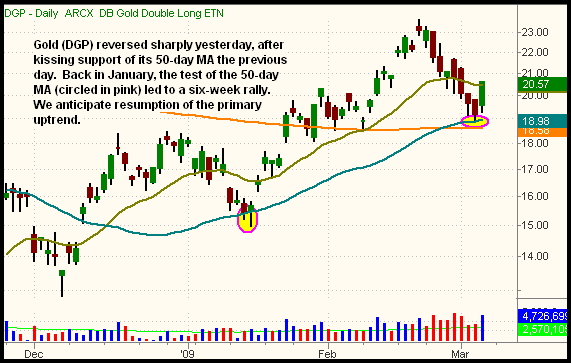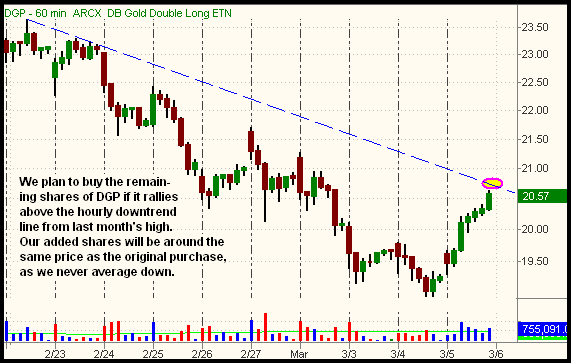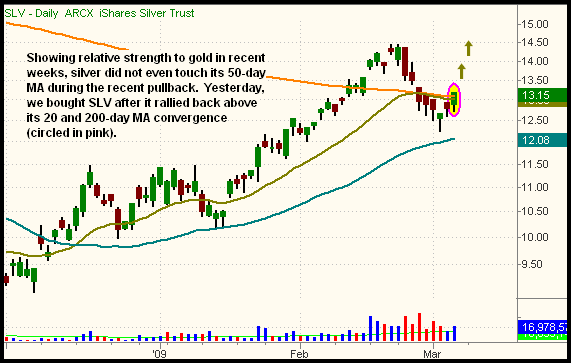|
The Wagner Daily ETF Report For March 6
Wednesday's rebound attempt turned out to be rather short-lived, as the major indices surrendered all of the previous day's gains and then some. Opposite of the previous day, stocks gapped down on the open, then trended lower throughout the session. The Nasdaq Composite plummeted 4.0%, the Dow Jones Industrial Average 4.1%, and the S&P 500 4.3%. Crashing 5.9%, the small-cap Russell 2000 was hardest hit of the main stock market indexes. The S&P Midcap 400 shed 4.8%. All the major indices closed near the bottom of their intraday ranges.
Turnover was mixed. Total volume in the NYSE ticked 4% higher, but volume in the Nasdaq edged 1% below the previous day's level. Market internals were ugly. In the NYSE, declining volume smashed advancing volume by a margin of 14 to 1. The Nasdaq adv/dec volume ratio was similarly negative by approximately 11 to 1.
On February 26, we bought a partial position of Gold Double Long (DGP) when it formed a bullish "hammer" candlestick at support of its 20-day exponential moving average (EMA). In the week that followed, DGP continued to pull back further, before coming into more significant support of its 50-day moving average on March 4. We bought our initial shares on February 26 because steadily trending ETFs often will not go beyond their 20-day EMAs before reversing to continue the dominant trend. However, because we entered with small initial share size and a wide stop, we intentionally accounted for the possibility that DGP could retrace further, down to its 50-day MA, and still maintain its primary uptrend.
After kissing its 50-day MA on March 4, DGP perfectly reversed higher yesterday, and closed right at resistance of its hourly downtrend line from last month's high. We plan to add the remaining shares to our DGP position if it moves above that short-term downtrend line. The daily chart of DGP shows how the 50-day MA perfectly acted as support, while the hourly chart that follows illustrates the short-term downtrend line DGP is poised to breakout above:


Also within the precious metals sector, iShares Silver Trust (SLV) triggered our buy entry yesterday. Showing slight relative strength to gold within recent weeks, silver also pulled back from its recent highs, but reversed before coming into support of its 50-day MA. Yesterday, SLV confirmed its short-term reversal by moving back above convergence of its 20 and 200-day moving averages, thereby triggering our buy entry:

After yesterday's close, we received an e-mail from a long-time subscriber, who asked us the following question, "When you see a position that is going against you and the market is dropping, and you are losing money on a trade, but your stop loss hasn’t been hit yet, how do you stay with the position? What is your secret? Do you pullback and look at the big picture or do you simply assume it's all noise as long as it doesn’t hit that lower low? This is my biggest problem with tracking your trades and most of the time you are right in holding on." We assume he may have been referring to DGP, which neared our stop below the 50-day MA the previous day, but reversed sharply higher one day later. Because we thought our answer to his question may be beneficial to other traders as well, we wanted to share our reply to his e-mail, which was...
"The key point you stated is 'but your stop loss hasn't been hit yet.' When we put on a trade, it's like entering into a contract, so we try to stay the course and simply follow the plan. Over the years, we've found it's best to stick with our original analysis because we usually plan a trade at night, or in the pre-market, without the stress of live trading. During the trading session, in the heat of the moment, there is so much pressure that we have to fight the voice in our heads telling us to sell the position when everything around is crumbling. It basically comes down to planning the trade and trading the plan...easier said than done, right? Sometimes, if you have a feeling things are going bad, and you're an active trader, you can maybe sell 1/4 or 1/3 of the position to ease your mind. However, you must have the discipline to get back in once the coast is clear. Try to lay out a plan, write it on paper, and stick to it. The one thing every trader must accept, in order to be successful, is a loss. You must be fully prepared to lose what you're risking. Once you accept losses as part of the trading game, the pressure to be right is not so intense. By the way, we at MTG are no different; we fight the same urges to sell that most traders do. It's a constant battle, that's for sure!"
Yesterday, both the S&P 500 and Dow Jones Industrial Average fell to fresh 11-year lows again. More importantly, however, is that the Nasdaq Composite joined the S&P and Dow by closing below its November 2008 closing low as well. In recent weeks, the one glimmer of hope in the broad market was that the Nasdaq Composite was still holding above its November 2008 closing low. Unfortunately for the bulls, that's not the case anymore. Without any signs of "capitulation," and with the Nasdaq tumbling below its November 2008 closing low, it's looking as though stocks want to make another leg down. Still, we're not excited about the reward-risk ratio of being short right now. Rather, we're simply focused on ETFs with a low correlation to the direction of the stock market (gold, silver, and gas). Even if our countertrend bounce play in QQQQ doesn't work out, we only risked half of the initial risk of a full position.
Open ETF positions:
Long - DGP, SLV, UGA, QQQQ
Short - (none)
Deron Wagner is the Founder and Head Trader of both Morpheus Capital LP, a U.S. hedge fund, and Morpheus Trading Group, a trader education firm launched in 2001 that provides daily technical analysis of the leading ETFs and stocks. For a free trial to the full version of The Wagner Daily or to learn about Wagner's other services, visit MorpheusTrading.com or send an e-mail to deron@morpheustrading.com.
|